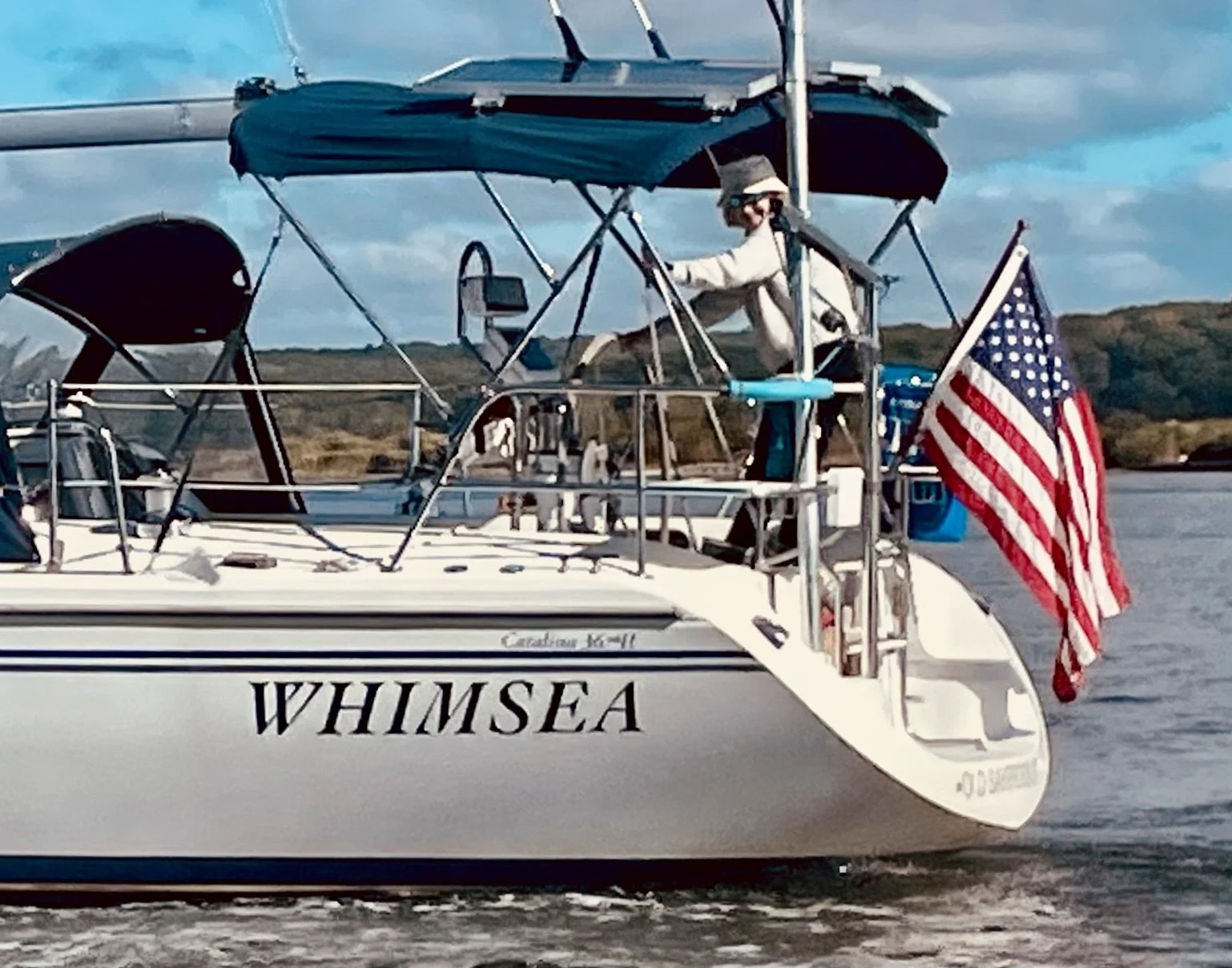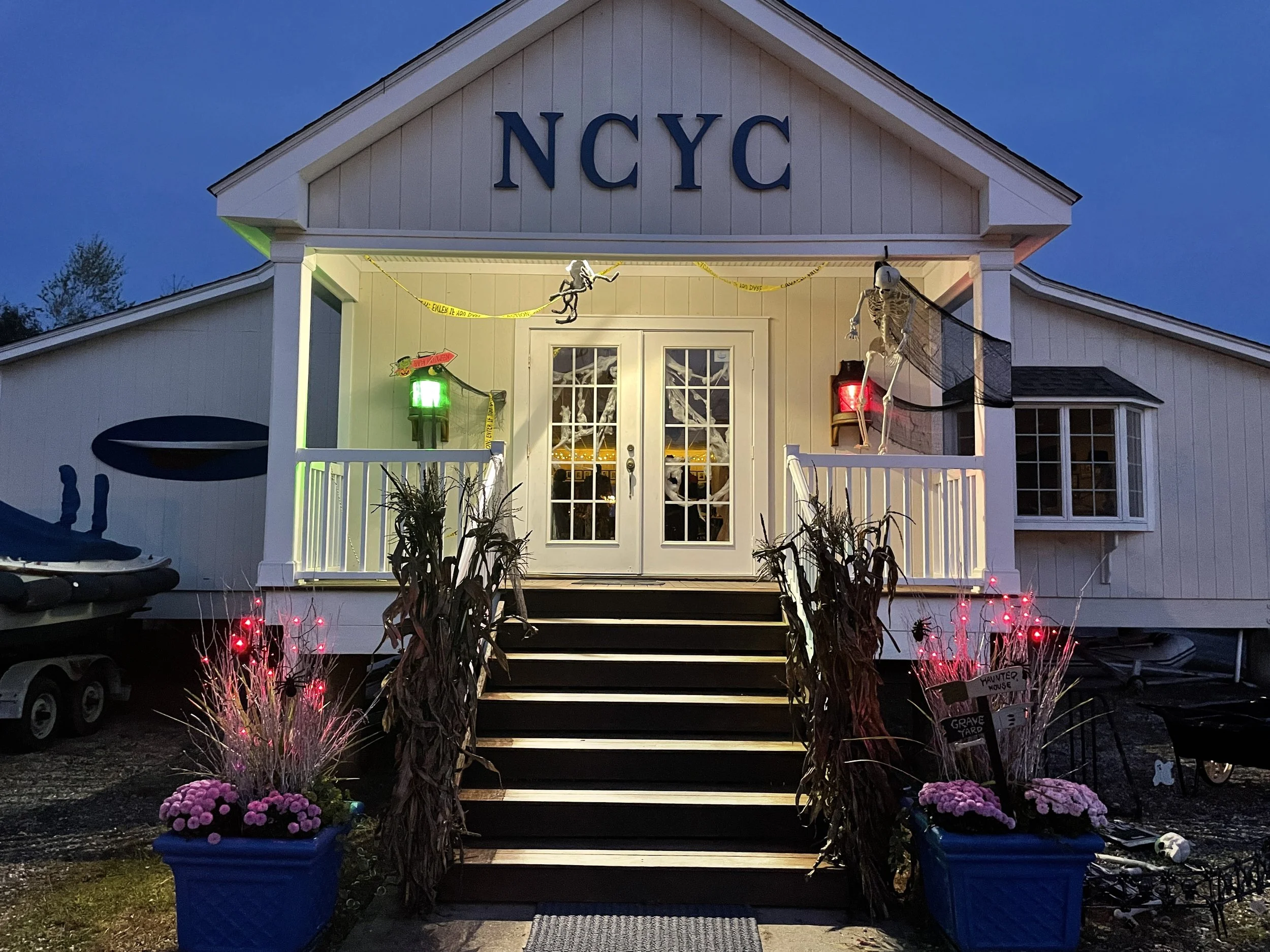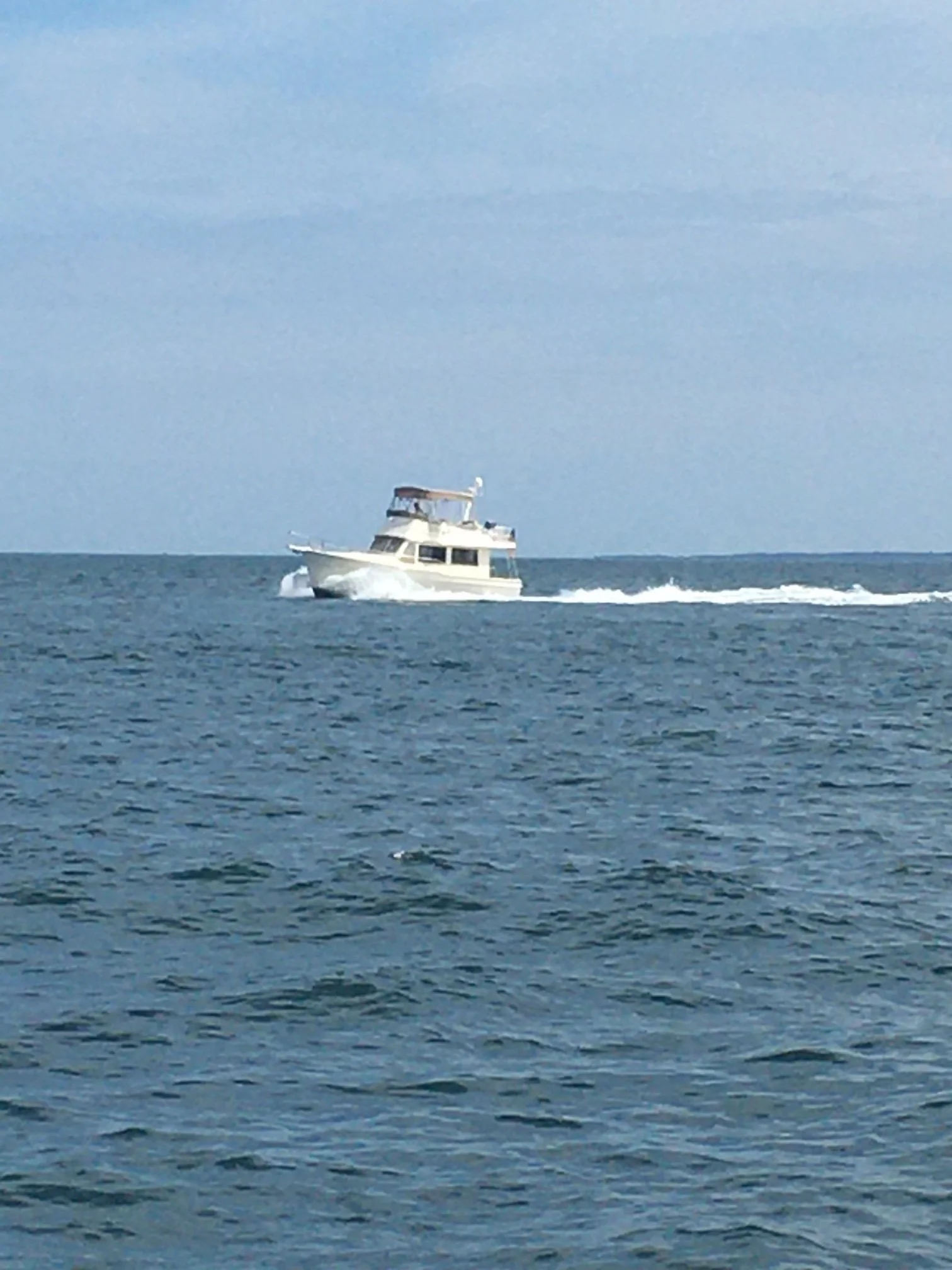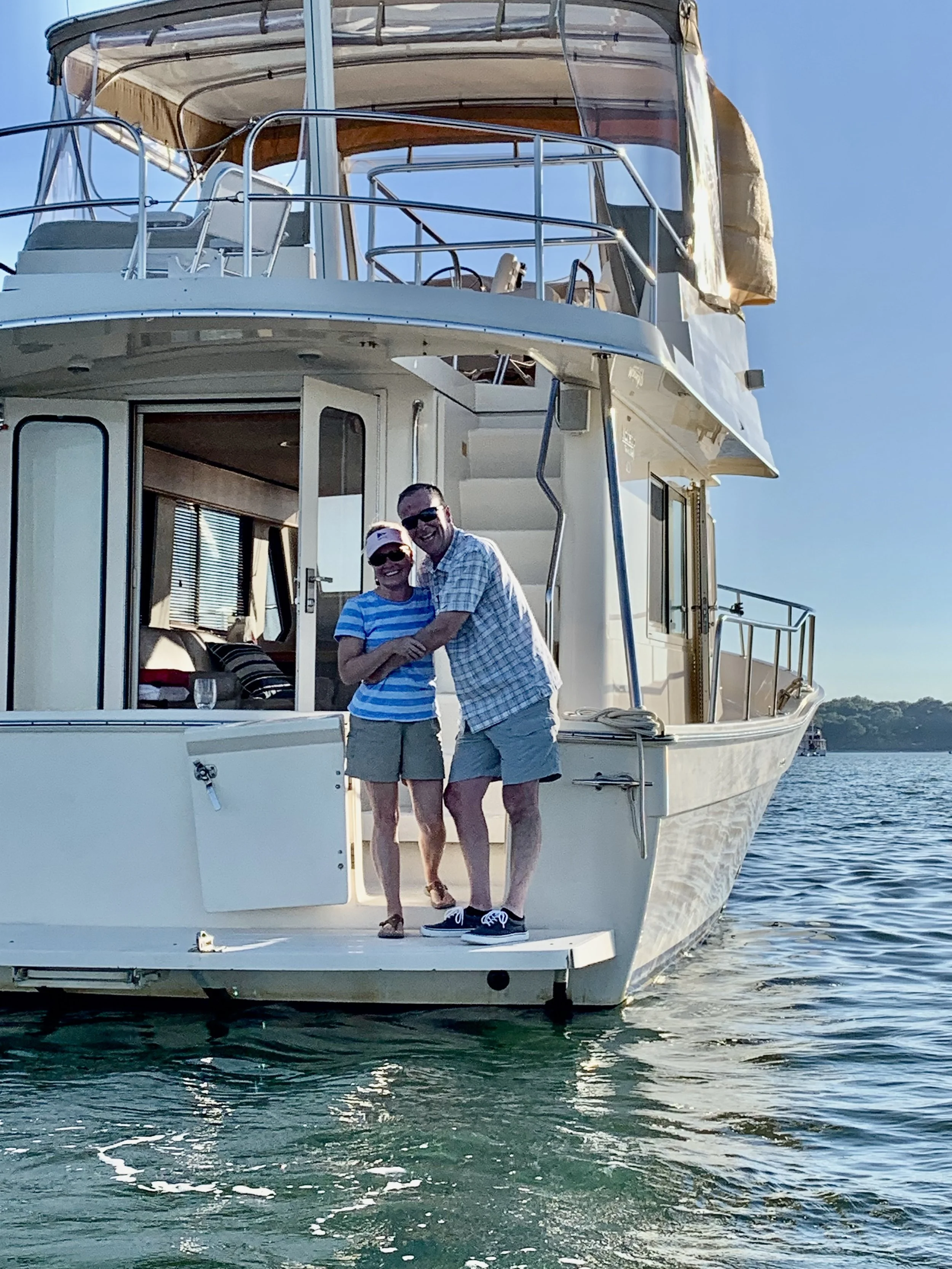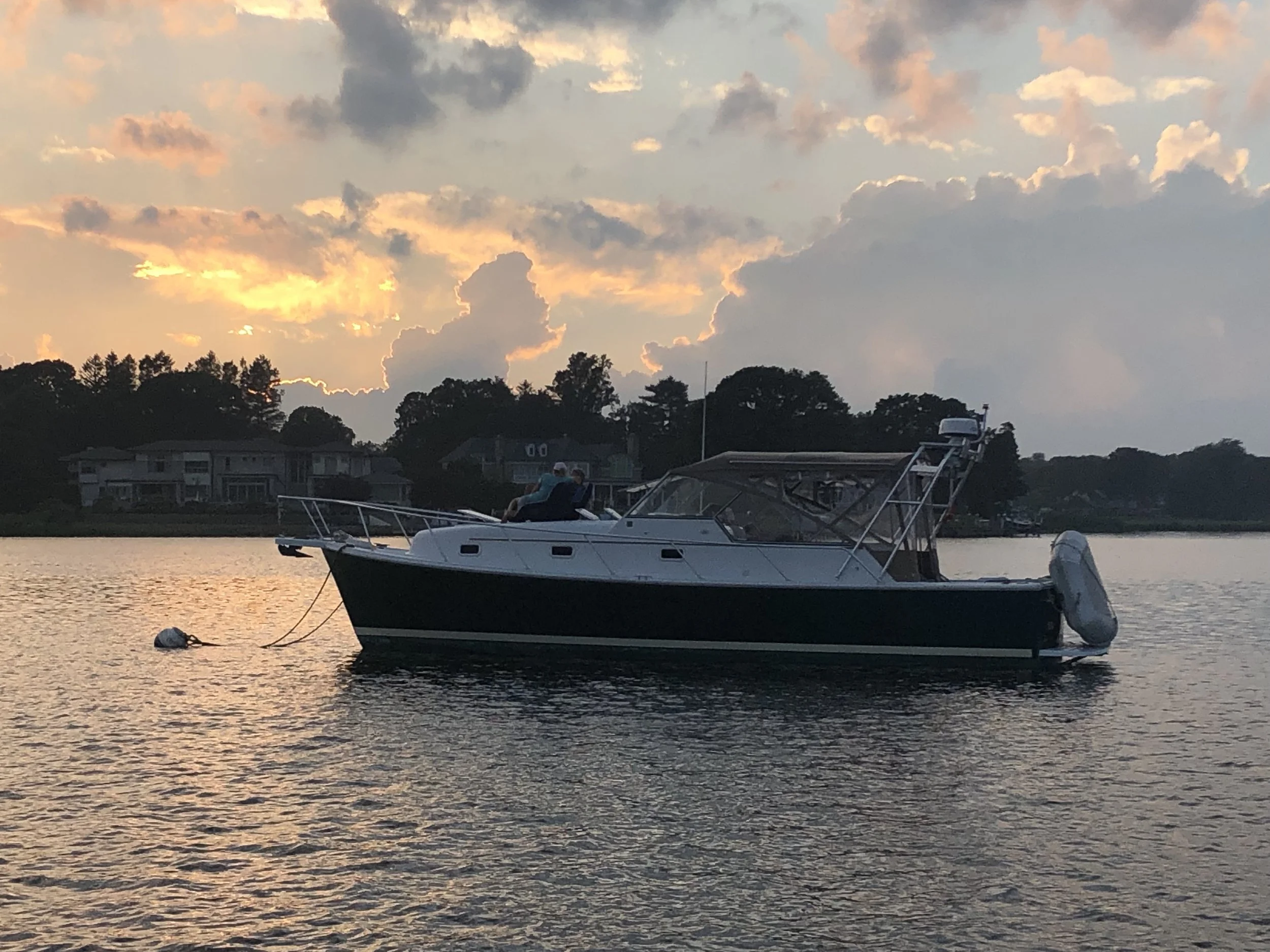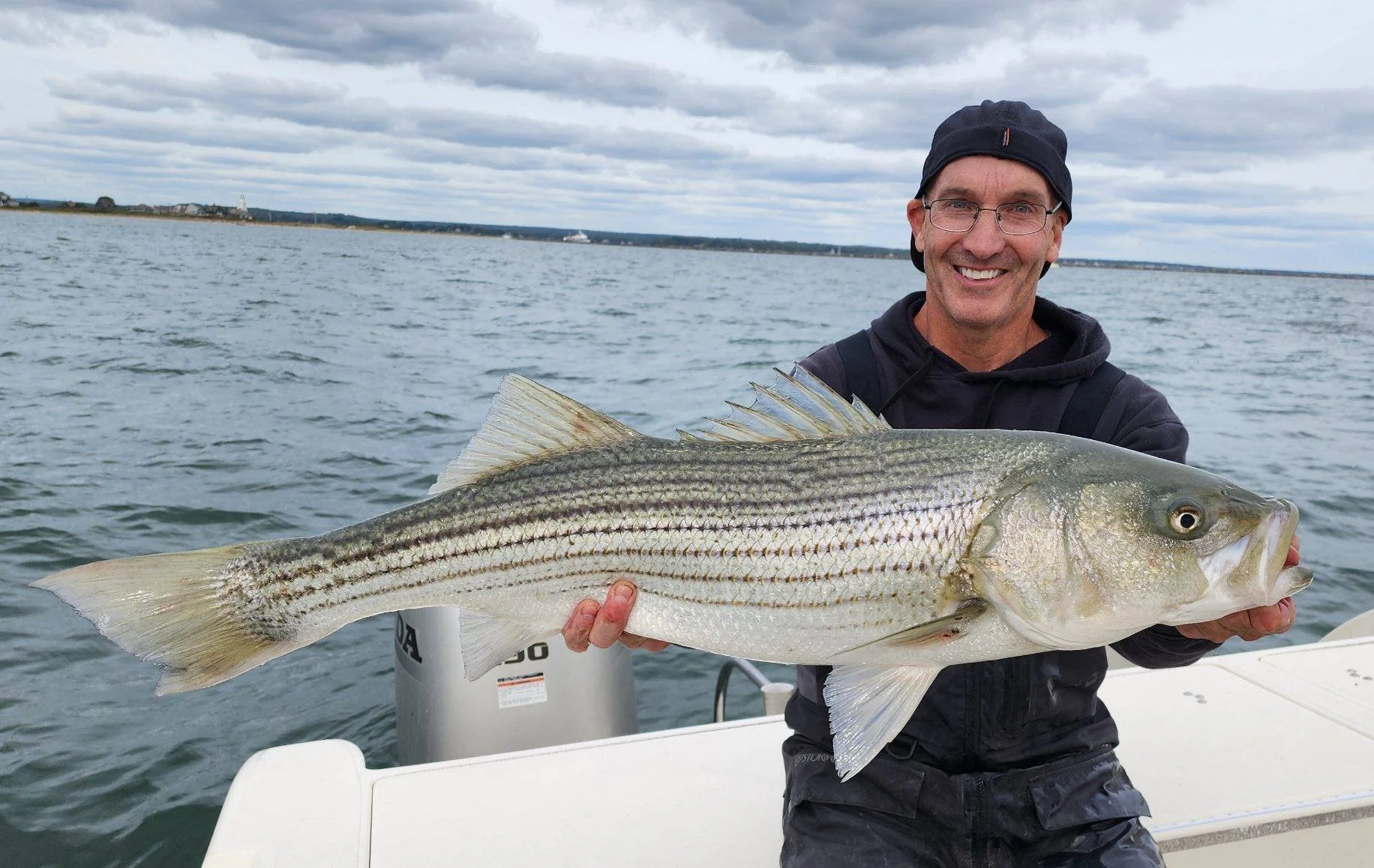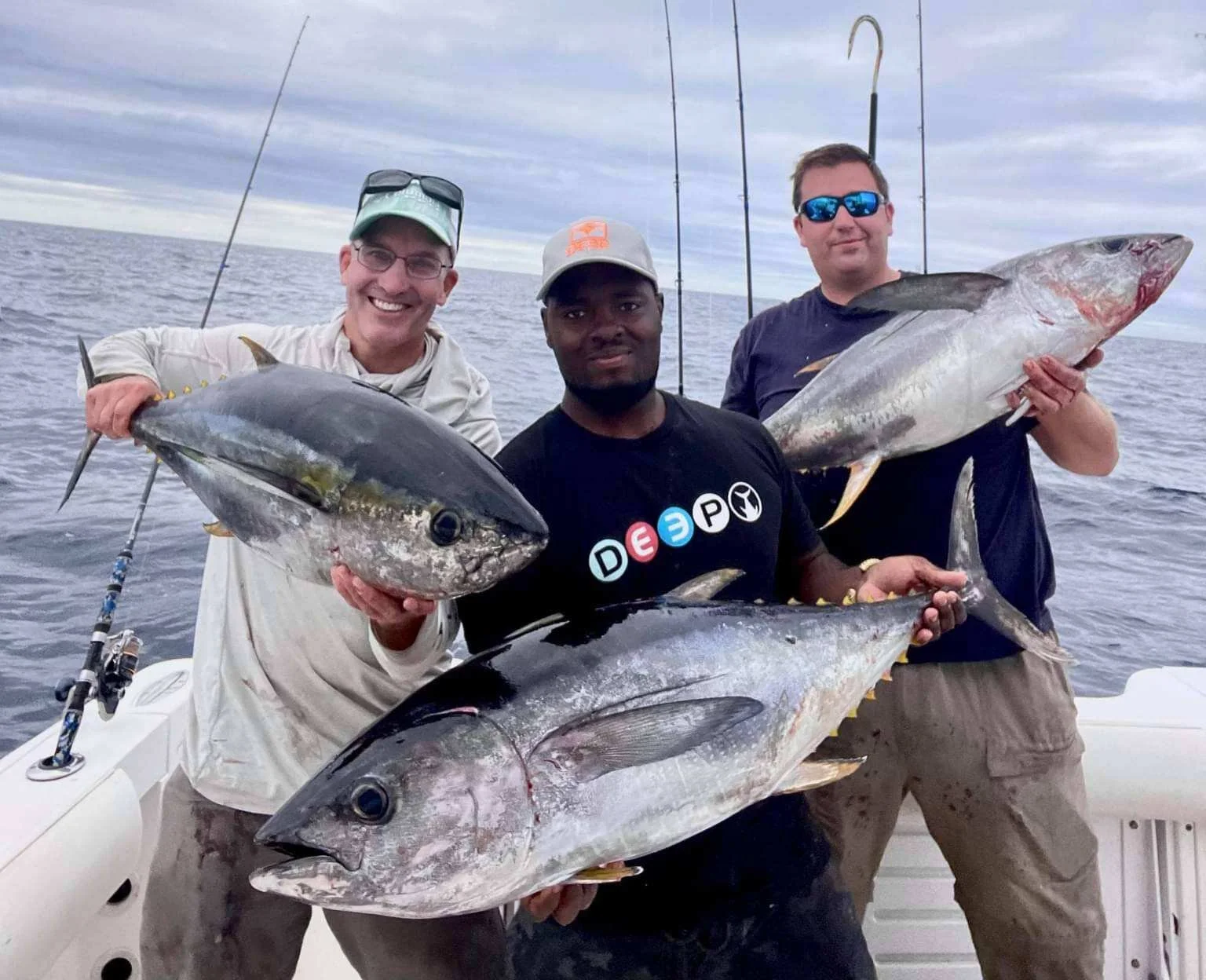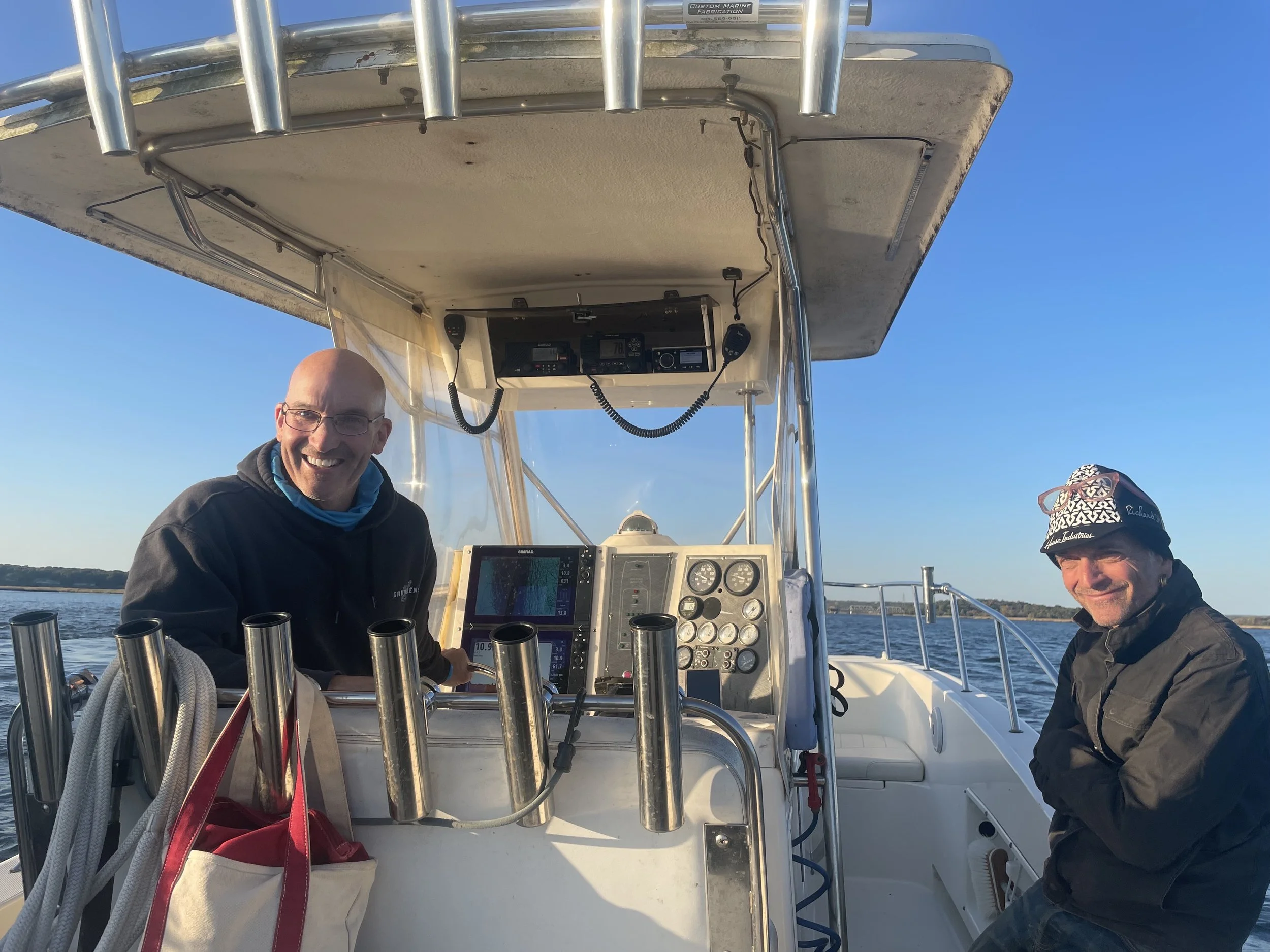High Tidings November 2022
/moonrise over north cove
Upcoming Events
Sunday November 6th 4 pm – NCYC Annual Meeting
Sunday November 6th after the Annual Meeting – Social hour after Meeting at NCYC
Saturday November 19th 9:30 am – NCYC Club Cleanup
Commodore Remarks
It is bittersweet writing this, as this is my last High Tidings as your Commodore. It has been a pleasure to work with, and become friends with so many amazing people. I especially want to thank Joe Milke, our Past Commodore for his eight years of service to the Club. Throughout my role as a flag officer, I have relied on Joe for his guidance. Joe had the difficult role as Commodore during the start of Covid. I wish him the best and know we will continue to see him around the Club volunteering on other projects.
Caroline at the helm of Whimsea
NCYC 53rd Annual Meeting - I hope to see everyone one at the Annual Meeting at the club house at 4 pm on Sunday November 6th. As I indicated in the last newsletter, attending the NCYC Annual Meeting is one of the most important responsibilities of being a member of NCYC. The annual meeting requires a quorum of members to vote on the new slate, on the budget, and any by-law changes. After the meeting, there will be a social hour at the Club (NOT at Penny Lane Pub as previously reported) to toast the outgoing Board and welcome the new Board and Flag Officers. You are welcome to bring an appetizer. Refreshments will be available at the Club or BYOB.
Here are a few reminders:
Moorings Once the harbormaster has finished pulling the moorings, come down to the Club to confirm that your mooring was placed on the Club Property and not on the town dock. The orange ribbons on the moorings indicate that your mooring should be placed on the NCYC property. If you are able to take your tackle home, please take it! We are hoping to have the deck replaced this winter and need to have as much room as possible for the construction.
Stewards Don’t forget your Stewards. The Stewards not only serve as launch drivers but as stewards of the Club. They look after the supplies, the Club House, the trash, and the grounds, as well as help the members. See below for the Steward’s addresses.
Club Cleanup Saturday November 19th at 9:30 am will be the club cleanup. This is always a “all hands-on deck” event. Check out the list of tasks we hope to accomplish. You can sign up for a particular task or just come and help. We even have a winter take-home polishing task if you can’t make it on the 12th.
Open Positions It is time to start volunteering for next year’s open positions. Please let Lou Vinciguerra know if you can help with any of the following:
o Grounds
o In-House Chair
o Moorings, Dock & Dinghy Racks
o Activities Chair
Outer Light Regatta Amy Vinciguerra is looking for a couple of volunteers to work with her this winter to plan the Outer Light Regatta. These plans may include a trip to Outer Light Brewery to see if they will help sponsor the event. Please reach out to either Amy or Lou if you are available.
Stewards
Tatiana (Tanya) Anderson
32 River Road
Old Saybrook, CT. 06475
Michael Misset
26 Deer Path Lane
North Branford, CT. 06471
Stefan Golicz
536 Main Street
Old Saybrook, CT. 06475
Jack Cardello
2 Deerfield Road
Old Saybrook, CT 06475
Activities
The season is winding down. A huge thank you to Melissa Clark and Lucy Driggs-Armstrong for organizing our Howling Halloween gathering-the last scheduled Social Gathering evening for the 2022 season. We had many members ‘get their costumes on!” It was hilarious to see all the many original and scary ideas for dressing up. There were prizes and spooky cocktails too. Thank you to everyone who helped decorate and undecorate and set up and clean up this gathering. One thing is for sure, we have a lot of Halloween decorations at the club, but if you can’t find what you need, just ask Melissa-- she has a whole store at her house.

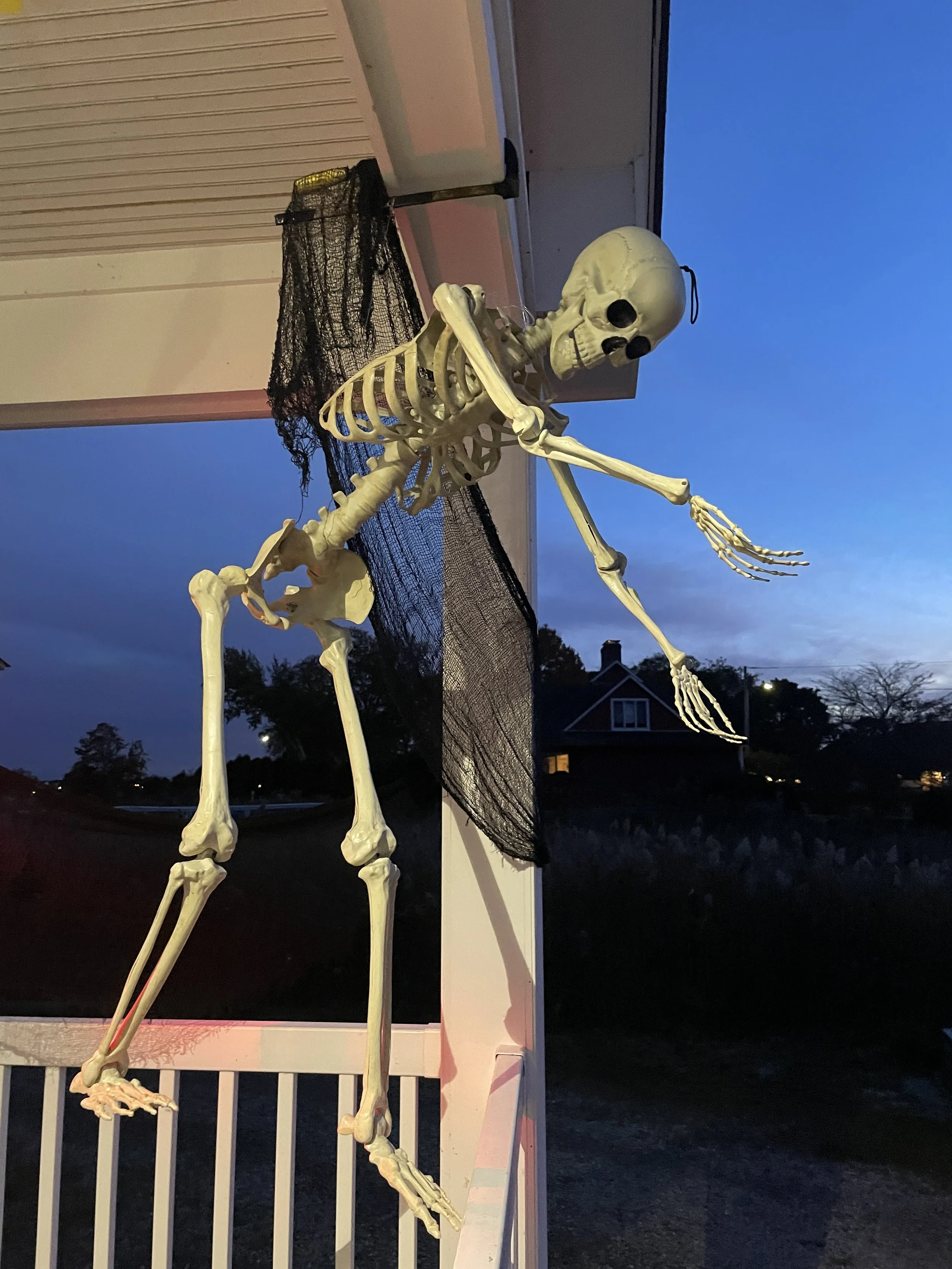


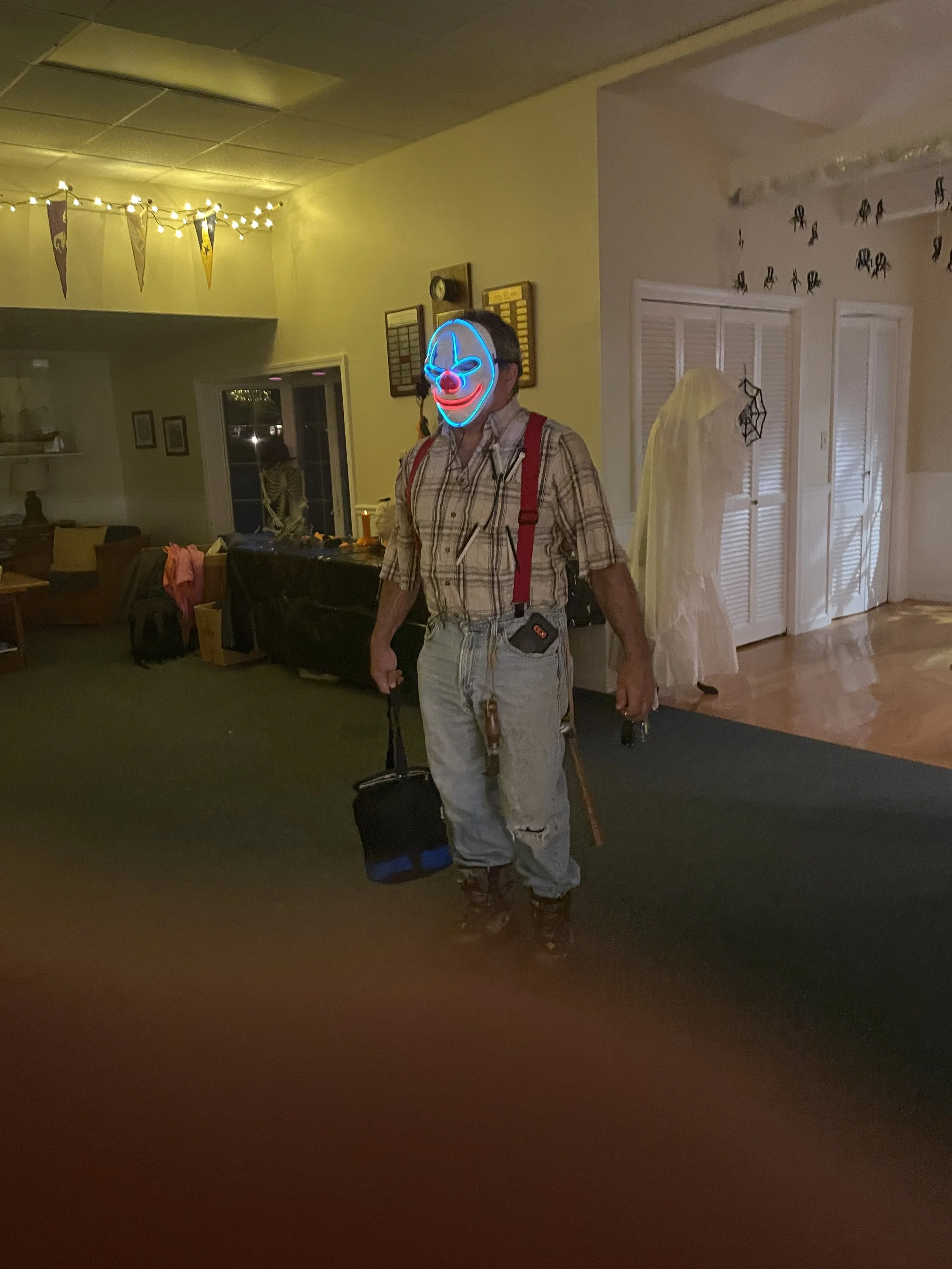
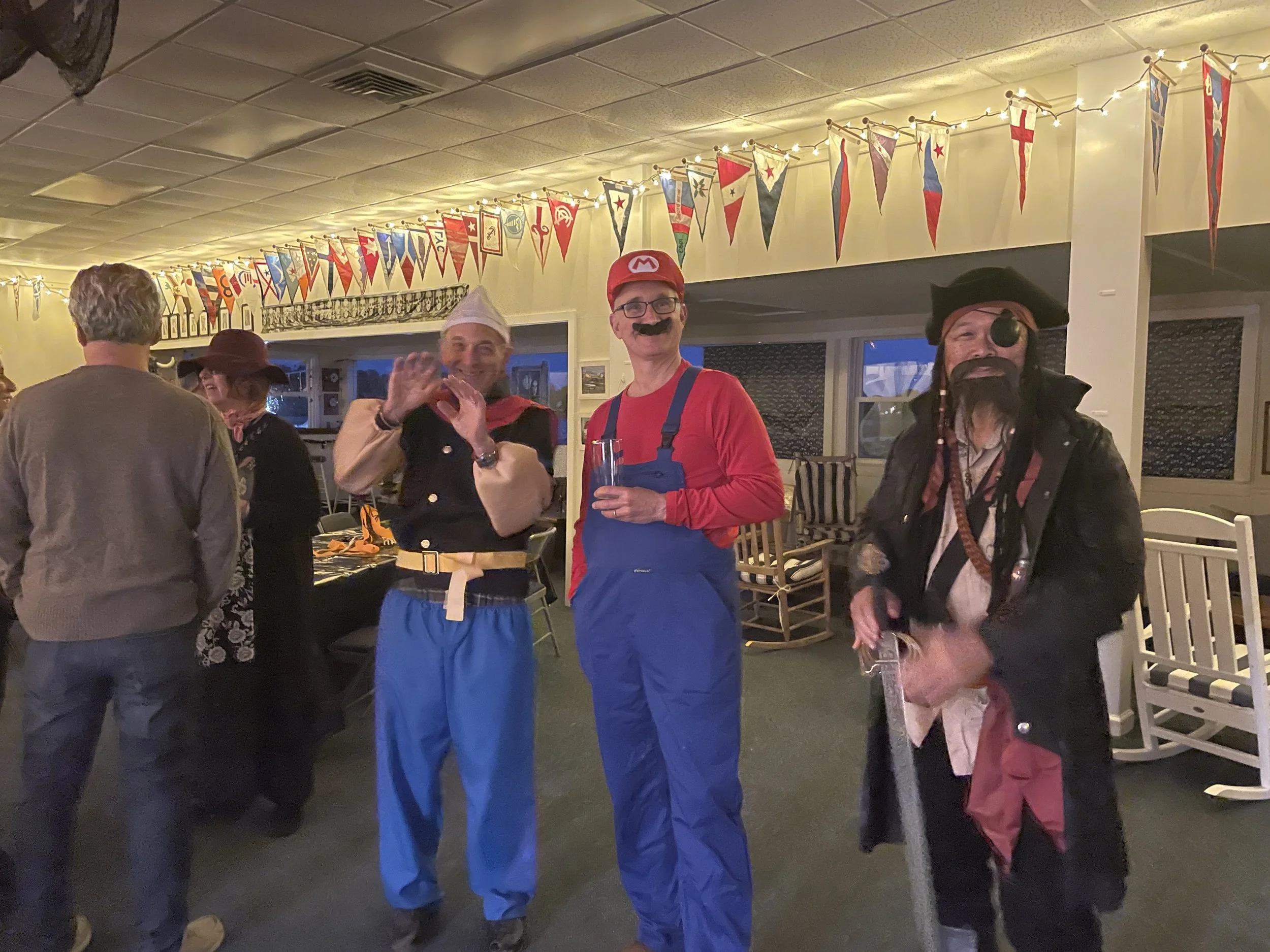


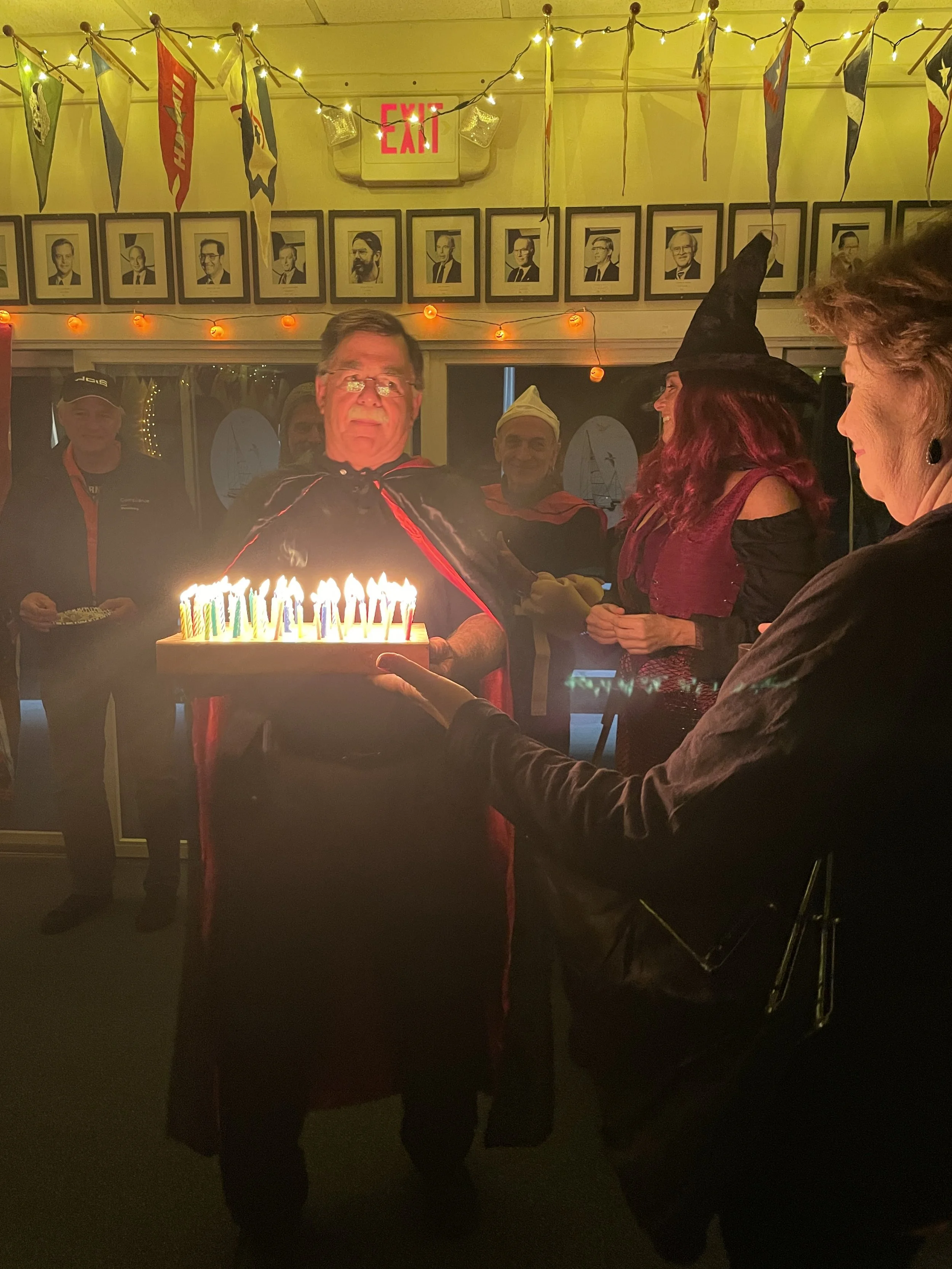

















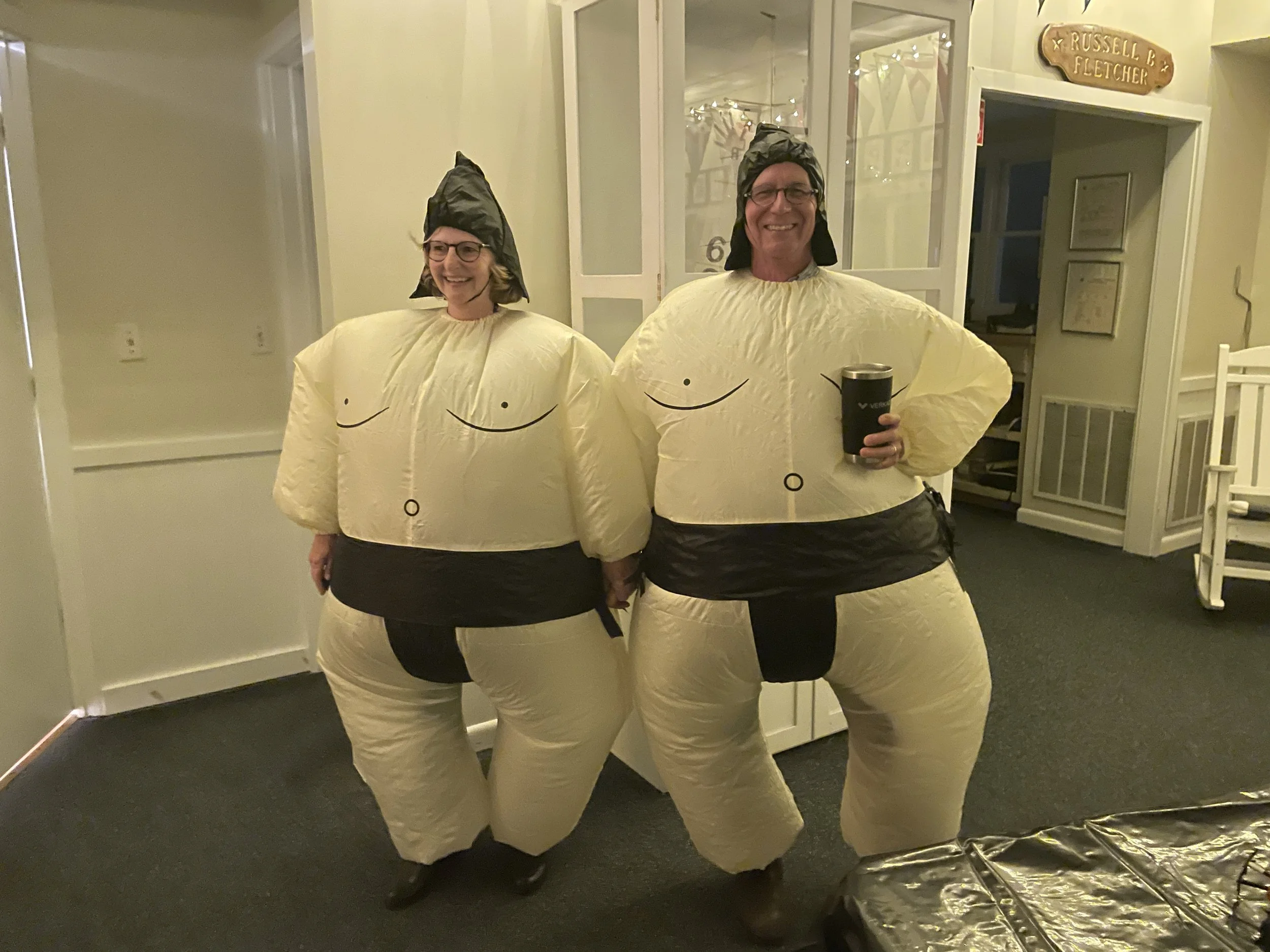
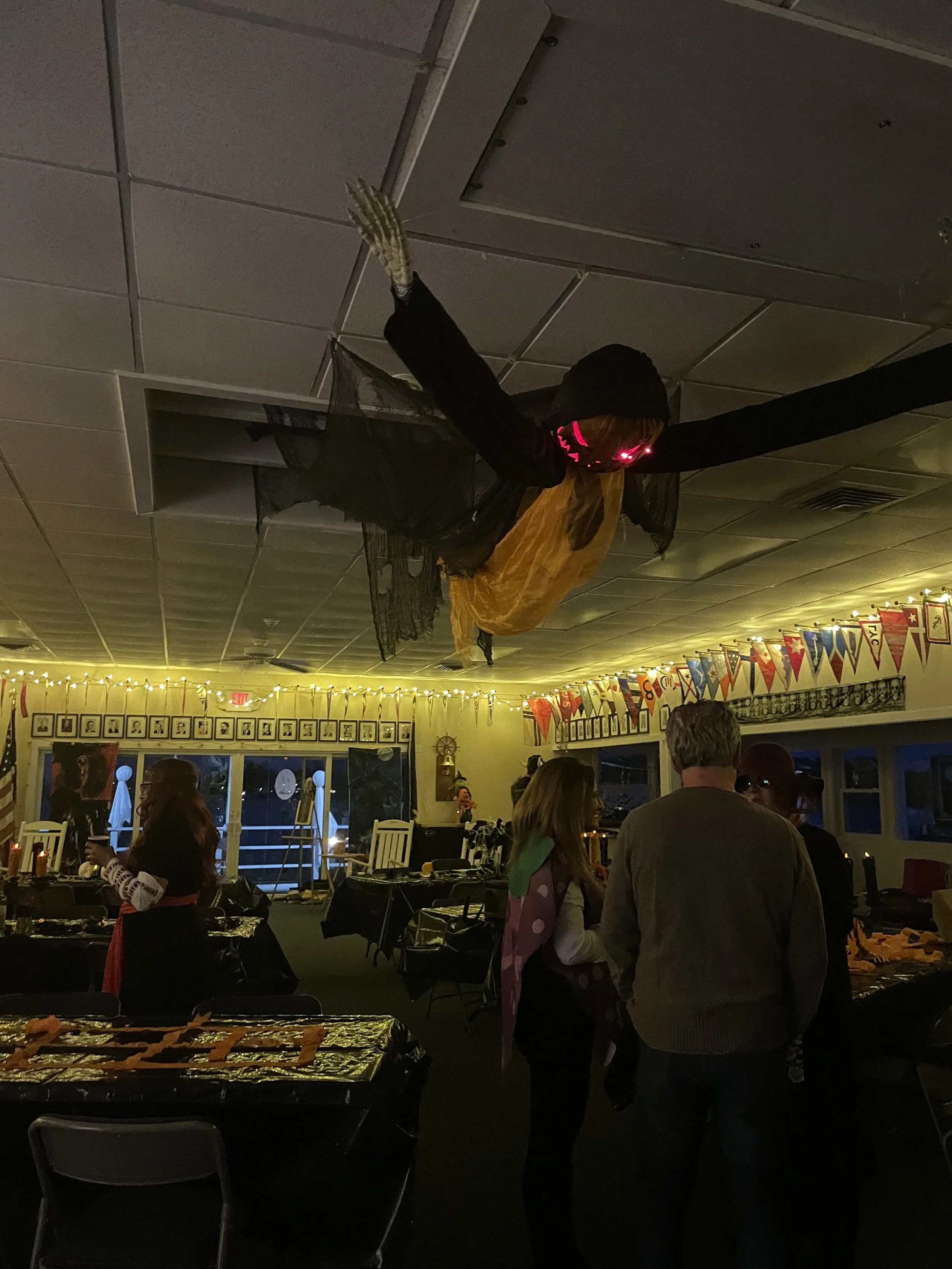





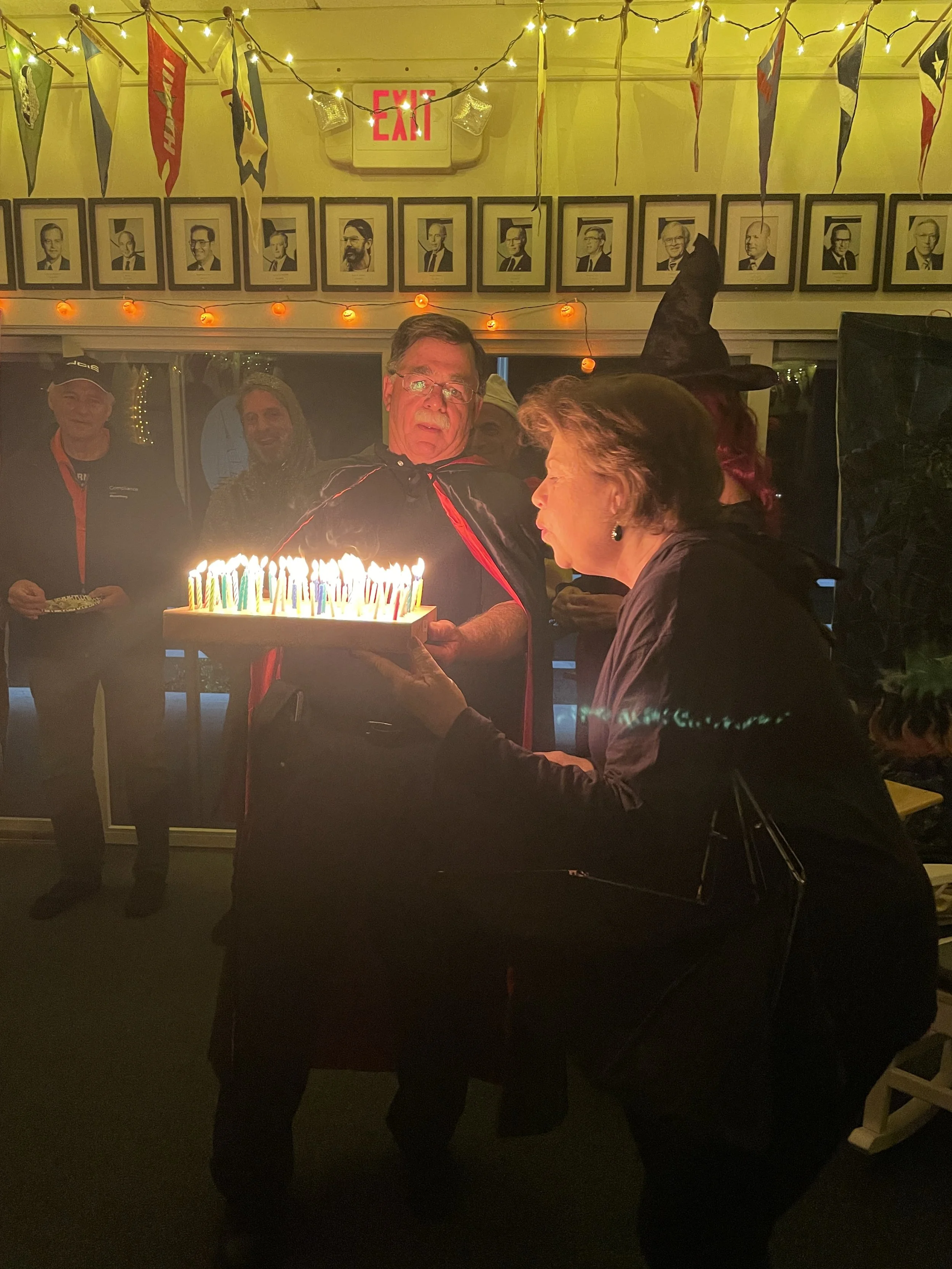





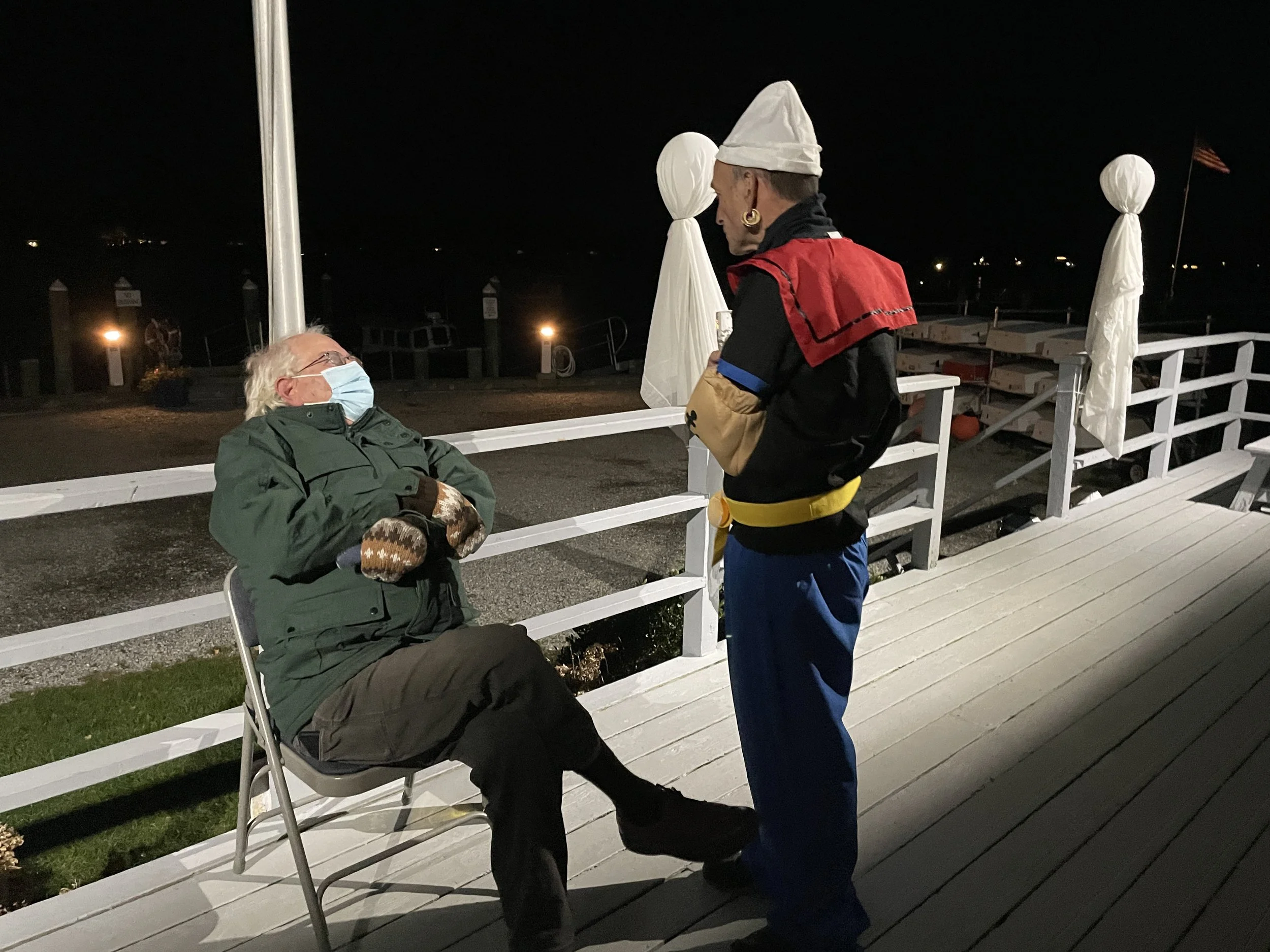
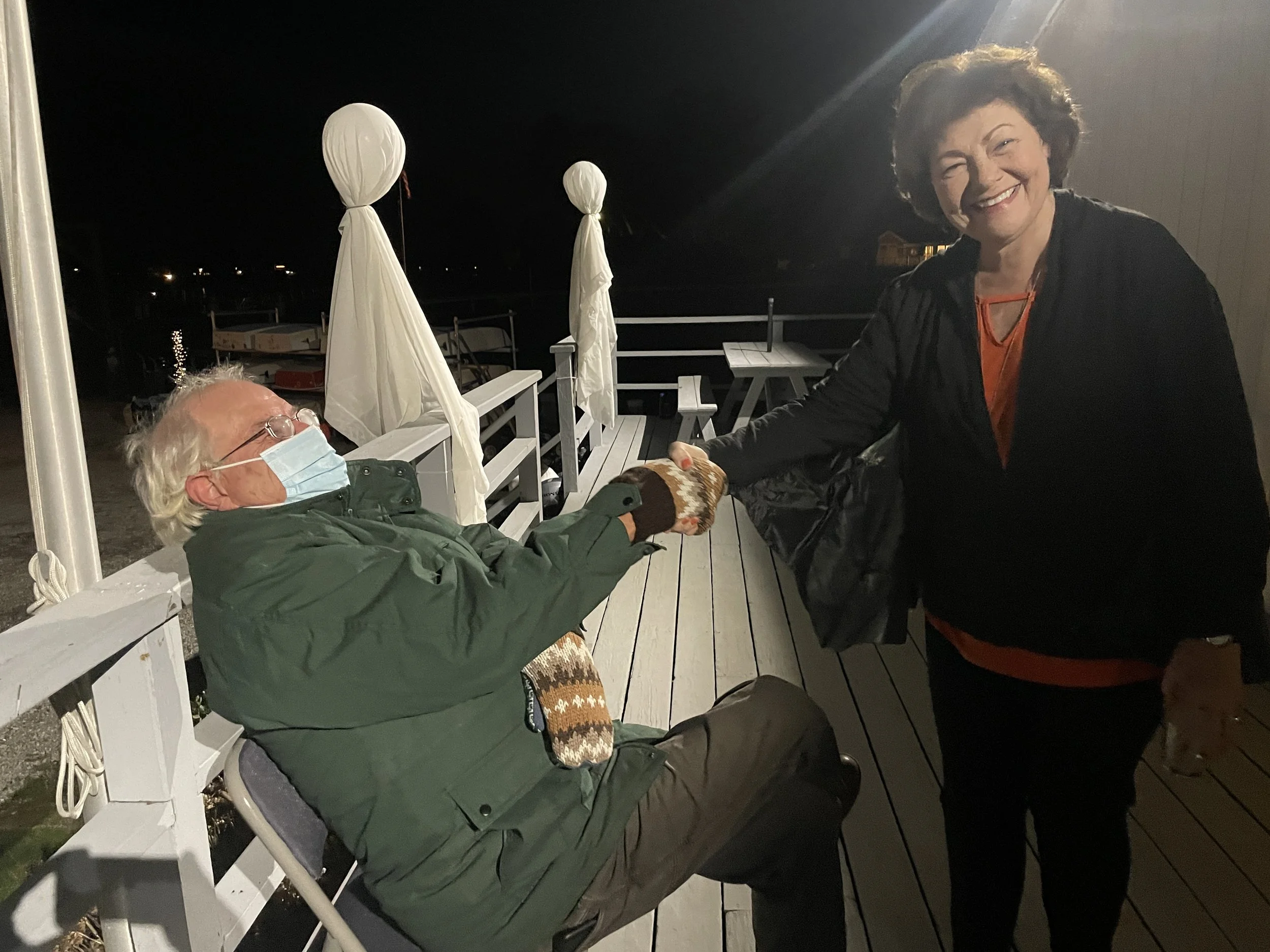




Next up is the Annual fall meeting, Sunday 11/6 at 4:00. It is very important for everyone to attend this meeting if possible. After the meeting there will be a social hour at NCYC.
We are still looking for someone to host the annual Open House at their home after the Torchlight Parade in Old Saybrook, which takes place this year on Saturday, December 10th at 6:00. This party usually starts right after the parade ends. All attending should be courteous and leave after about 2 hours unless you are part of the cleanup crew. Everyone brings a bottle and an appetizer to share. Activities members can help with setting up, organizing and, of course, clean up if need be. Please let us know if you have any questions or will be willing to host your fellow members at your home.
Hopefully we will get to see all of you at one or two get-togethers during the months the clubhouse is closed. If anyone has any ideas for places we should look into for having a gathering, please get in touch with the Commodore.
Thank you for all the help and support this year. We have had fun working with all of you. None of our gatherings would be possible without all of you. We can always depend on many of you to step up when we need you most.
See you all at the Annual meeting.
Ann Chan and Cathy Murphy
Activities Co-chairs
Fun Winter Activity
Laurie Pavlos recently sent the Commodore an article about a woman from Denmark who was a member of the BlueTits (!! ed.) Chill swimmers. The BlueTitters believe that swimming (or dipping) all winter is good for one’s mental health, as well as for general exercise and companionship. BlueTits is a global community with members worldwide. Here is a link to their website:
A few from NCYC want to see if they can get a group started – all are invited. If you are interested in joining our weekly dip (or swim), we will be at the Club this Friday at 11:00 am. Be sure to wear your bathing suit! Tea and cookies will be served after the dip.
Here are the group’s first photos taken last week with a balmy water temperature of 58 degrees F.
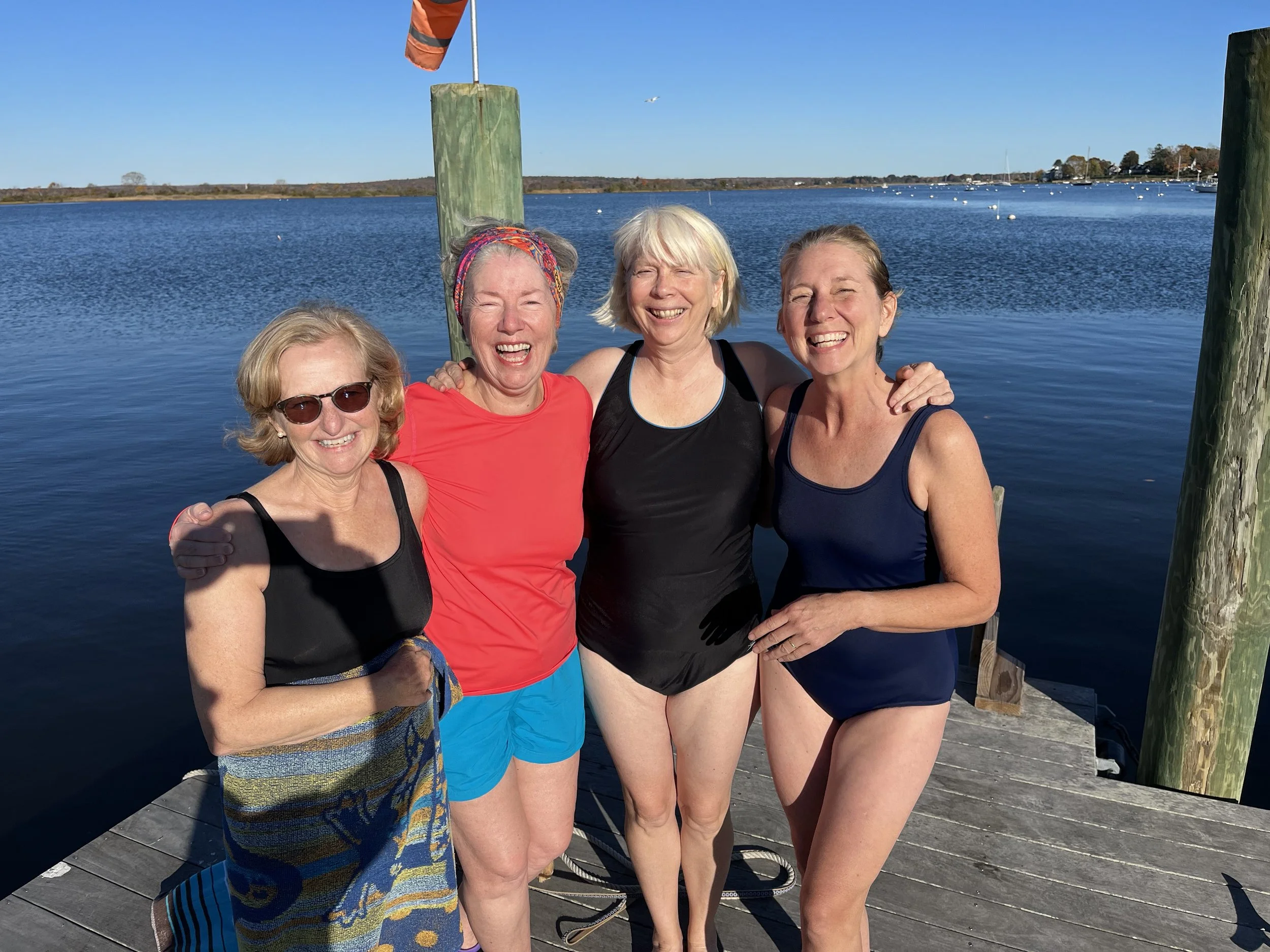
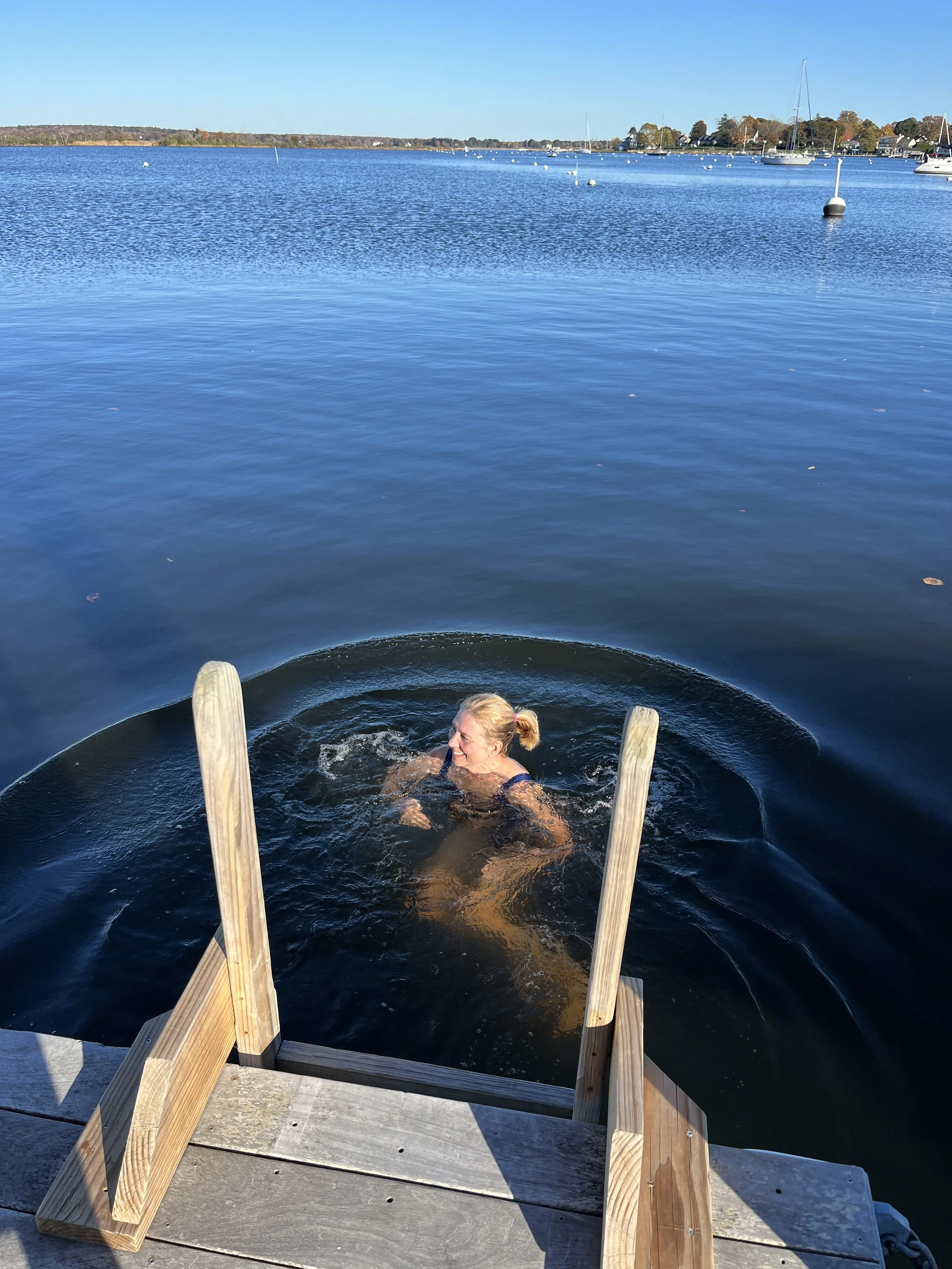

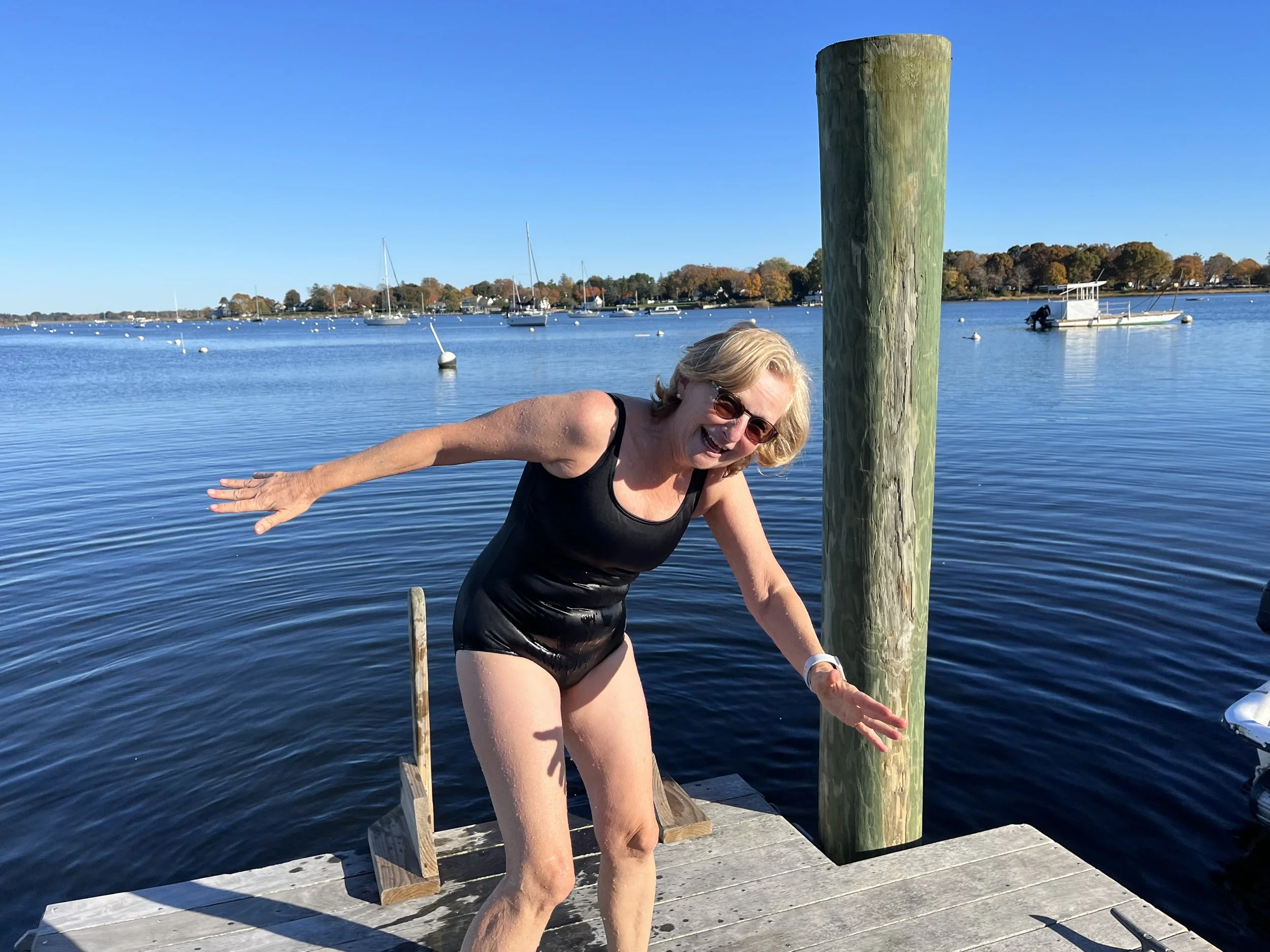
Power to the People
A closer look at some of our power boat members
Jen and Karl Frost
Pau Hana/ Mainship Trawler 34
The Milke’s are partly responsible for our cross-over from sail to power. Years ago, on the first night of a rainy club cruise, they invited everyone aboard Kindred Spirit, their 36 foot Sabreline fast trawler. Inside there was dry space for everyone, a view of the harbor from every big, bright window, teak and holly sole, and ice, lots of ice!
At the end of last season Karl texted me to ask what I thought about putting Risky Business, our Pearson 36 sloop, on the market. Selling Risky Business was a bittersweet idea because the boat belonged to my parents, and my dad passed away in 2017. Dad had left a little sign though, a tiny framed cartoon mounted above a bunk, of two salty sailors. The thought bubble read: “I went on a power boat and I liked it!”
Just a couple of months later, Pau Hana found us, and we love it!
Lisa and Craig Elliott
Serendipity/ Mainship 34
David MacVaugh
Ibis and Half Moon Too/ Devlin 26 and 22
A three-day stopover in North Cove about eight years ago spun my life in a direction that it could not or would not have ever in my wildest dreams thought possible. I attribute that to the sheer “cuteness” of my little boat, the Half Moon Too. If I had owned any other boat, I am convinced that no one would have talked to me, let alone made me feel as welcome as the folks here in Old Saybrook.
I’ve tried to live my life according to the Quaker philosophy of “live simply so that others may simply live.” My new boat, Ibis, or as I like to refer to her, my “pied a mer” has allowed me to enjoy all the Cove has to offer in a bit more comfort—and most importantly, with room for the kitty litter box for Dewey (aka Moochie) and Lucy, my shipmates.
Words cannot express how much I have enjoyed these last six weeks here in the Cove and the new friends that I have made.
Al Ebstein
Doubled Up/ Worldcat catamaran
From the Chaplain’s Quiet Corner of the Cove
May the nourishment of the earth be yours, may the clarity of light be yours,
may the fluency of the ocean be yours
may the protection of the ancestors be yours.
And so may a slow wind work these words of love around you,
an invisible cloak
to mind your life.
Closing Prayer for the season on All Hallows’ Eve and All Saints’ Day
From Beannacht by John O ’Donohue
Winterizing Your Engine
BoatUS magazine generously allows boating newsletters to republish selected articles. Full attribution is given at the end of this article.
Your Engine’s Chillin’
It's that time of year again. Before the mercury dips below freezing, you need to winterize your engine or risk missing next year’s boating season
By Beth A. Leonard
Fresh water expands in volume by about nine percent when it freezes and can push outward with a force of tens of thousands of pounds per square inch. An analysis of 10 years of freeze claims from the BoatU.S. Marine Insurance claim files found that more than three-quarters involved cracks in the engine block or the exhaust manifolds because water remained in the engine or cooling system during a hard freeze. Those claims come from all over the country, not just from the states that get snow every year. Unless you’re located in Hawaii or the Florida Keys, BoatU.S. recommends winterizing your engine if you’ll be laying up the boat for even a few weeks. It will minimize the chances that a sudden freeze will put you out of commission next season.
Engine Winterizing 101
At its most basic, winterizing means draining any water aboard or replacing it with enough of the right kind of antifreeze to protect against the lowest temperatures your boat might experience. No matter what kind of engine you have, there are four essential winterizing steps:
Change the oil and oil filter. Residual acids and moisture left in the crankcase over the winter can pit bearings and other vital engine parts, so it's important to change the oil just before laying up the boat. For best results, run the engine for a few minutes to lower the oil's viscosity and pick up impurities. Shut off the engine, change the oil, and replace the filter. Restart the engine and run for about a minute to circulate the fresh oil to internal parts. While it's running, check to make sure the oil filter isn't leaking.
Change the fuel filter and stabilize the fuel. Running the engine after this step ensures stabilized fuel reaches critical fuel system components. Replace the primary and secondary fuel filter(s) and/or change the fuel filter canisters. Like the oil filter, the fuel filter should be checked for leaks while the engine is still running. If your boat runs on gasoline and your gasoline has ethanol in it (E10), the ethanol will absorb moisture over the winter. If it absorbs enough water, the ethanol can separate from the gasoline, creating a caustic mixture at the bottom of your tank that can damage the engine. This process, called phase separation, can only be completely prevented by emptying the tank. If that isn't practical, add stabilizer to keep the gas from oxidizing over the winter, then fill the tank to 95-percent full to allow for expansion. A tank that's almost full has less "lung capacity" to breath in moist air, so the ethanol should not be able to absorb enough moisture to separate.
Diesel tanks should also be left full over the winter to minimize condensation and algae growth.
Drain the water from the engine or use antifreeze. This is the part that seems most often to confuse owners, and mistakes in this step lead to the vast majority of the freeze claims in the BoatU.S. Marine Insurance files. Exactly how this is done varies from one type of engine to another, as described below.
TIP: The oil will be much easier to remove if you let the engine warm up to operating temperature first.
Winterizing An Inboard
Most boat engines these days are fresh-water-cooled. That means there are actually two systems – a raw-water side and a closed-loop system that contains a coolant/water mixture. The raw-water side cools the coolant/water mixture, which in turn cools the engine.
Winterizing the fresh-water side simply involves making sure its year-round permanent coolant is an adequate mixture of mixture to meet the manufacturer's recommendations for your locality, typically a 50/50 mix with water. The coolant you use in the fresh-water system is not the same as what you’ll use on the raw-water side of the engine - ethylene glycol is effective but highly toxic. With the engine at room temperature, slowly remove the cap on the expansion tank and check the mixture with an antifreeze hydrometer. If the coolant is rusty or dirty, it needs to be drained and replaced with a fresh mixture. (Resist the temptation to use more than 50-percent coolant. An overly rich mixture will congeal, with 100-percent antifreeze turning to a solid gel at -8 degrees F.)
The preferred technique for winterizing the raw-water cooling side of a fresh-water-cooled engine, circulating nontoxic antifreeze (propylene glycol) throughout the cooling system, protects the engine better than draining it and, assuming that the antifreeze you use also contains rust inhibitors, can actually extend engine life. It also is far less likely to result in freeze damage, as long as the engine is run long enough to circulate the antifreeze to every part of the cooling system. On some boats, it can be difficult to reach the intake hose for the engine, or to get it off the seacock. A variety of products have been designed to make getting antifreeze into the engine possible without undoing that hose. These include three-way valves that attach to the seacock or the sea strainer, funnels that fit inside the sea strainer, and reservoirs with hoses that can be run to the raw-water intake. Google "boat winterizing products" and you'll find a selection. If you choose to use one of these, just be certain that the antifreeze reaches everything downstream of where you're adding it, not just upstream. To winterize the engine with antifreeze the old-fashioned way, you'll need a five-gallon bucket and enough antifreeze for your engine and related plumbing (at least two gallons). If your engine takes a lot of antifreeze, you might also need a helper to add antifreeze to the bucket as needed. Note that in raw-water-cooled engines a thermostat blocks water flow in some cooling passages until the engine heats up. To be thoroughly protected, raw-water-cooled engines must reach operating temperature and the thermostat must be open before adding the antifreeze. One method is to remove the thermostat, a simple job on most engines. It can be left out for the winter, but don’t forget to reinstall it in the spring along with a new gasket.
To circulate antifreeze through the engine:
If the boat is in the water, close the intake seacock.
Fill a five-gallon bucket with antifreeze. Have additional antifreeze handy if you know your boat takes more than that, or if you've never winterized before. You can use any leftovers in the boat's plumbing systems.
Remove the raw-water intake hose from the seacock (this is sometimes difficult, as hose clamps and hoses may be mechanically frozen in place) and insert the end in the bucket.
Start the engine and run at idle until antifreeze discharges from the exhaust outlet for 30 seconds or more.
For gasoline engines, fog the cylinders (see below).
Shut off the engine and secure the intake hose back on the seacock.
In addition to the bucket and the antifreeze, for gasoline engines you'll also need a can of engine fogging fluid or light motor oil, some plastic sheeting, and duct tape.
If a fuel valve is installed, turn it off about halfway through the process to run the carburetor dry. For the last 10 seconds or so of engine operation, spray the fogging fluid into the flame arrester on the carburetor. Light oil can be trickled down the carburetor if fogging fluid isn’t available. This may stall the engine, which is OK. Finally, wrap duct tape around the flame arrester and cover the top of the engine with plastic after it has cooled. This helps prevent corrosion from forming on internal engine parts. Attach a tag somewhere as a reminder about the duct tape, which will prevent the engine from starting next spring. Note that diesel engines don’t need to be fogged.
TIP: Use only nontoxic antifreeze (propylene glycol) everywhere except in the fresh-water side of the engine.
Winterizing Sterndrives
There are different types of sterndrives, so check your manual for winterizing specifics. Some inboard/outboard (I/O) engines take in cooling water from a thru-hull in the engine compartment, and some take it in through the outdrive. With I/Os that use a thru-hull, the outdrive will be protected once the engine has had antifreeze run through it because the antifreeze also runs through the outdrive. Other models may require the use of “muffs” to first flush and then run antifreeze through the drive. For those drives, warm up the engine with the muffs, then use a five-gallon bucket of antifreeze plumbed to the muffs and run the engine until it’s all been run through. Afterward, all outdrives should be stored in the down position to prevent water from entering the exhaust hub of the propeller. In cold weather, any accumulated water in the outdrive can freeze and ice may expand and crack the housing.
While not technically necessary for winterizing, it makes sense to drain and fill the outdrive oil now. It’s not difficult and will protect your outdrive from the effects of worn-out lube over the winter while letting you hit the water faster in the spring. Lower the outdrive as far as possible, and drain the oil by removing the lube drain/fill screw at the bottom and the vent plug screw at the top. Keep in mind that refilling your outdrive oil is counterintuitive: New oil must be pumped UP into the outdrive; never refill from the top port or vent hole. Pump fresh oil into the drive from the drain hole at the bottom until fluid appears out the vent hole at the top. Install the vent screw, which slows the lube from coming back out the drain, and then replace the drain/fill screw quickly. It’s a good idea to put new gaskets on the plugs. If your boat has a reservoir in the engine compartment, fill it also.
Outdrives are expensive and have become a frequent target for thieves. Even if the boat is kept in your driveway, consider taking the outdrive off and storing it in your garage or basement for the winter.
TIP: Heaters are not a good alternative to winterizing – if the electricity goes out, your engine is left unprotected, and a fault in the heater, cord, or electrical system could cause a fire.
Winterizing Outboards
Consult your engine owner's manual or service manual before you begin. Today's engines (especially four-stroke and direct-injected two-stroke outboards) may have special winterizing, flushing, and maintenance instructions, so follow them closely. For example, Evinrude's E-Tec outboards feature a self-winterizing mode in the engine's electronic programming. It's simple to do by following the instructions in the winterizing section of the owner's manual, yet if you don't know about it, you might be tempted to try it the traditional way. If your engine is still under warranty, and you don't winterize it according to the manufacturer's instructions, you could easily void the warranty coverage. While winterizing procedures vary somewhat for older engines versus newer ones, and for two-stroke versus four-stroke outboards, the basics are the same.
The engine's gas tank must be filled and treated with stabilizers or drained completely.
The engine should be flushed according to the manufacturer's instructions. Sometimes, this doesn't involve running the engine at all; newer engines have a garden hose fitting that allows for a quick flush without starting the engine. Check your manual for specifics.
The engine's lubricants (engine oil for four-stroke outboards, and lower-unit gear lube for all outboards) should be drained and refilled, and the fuel filters changed. Water or other contaminants must be flushed out and replaced with fresh lube before winter. Any water present in the gear case, for example, will sit on steel shafts and bearings over the winter, coating them with rust.
Run the engine (use a small portable tank that has stabilizer mixed in if you’ve drained the main tank) to get the oil and lower unit lubricant warm before draining. This will make it flow easier and also get any contaminants in suspension so they drain instead of sitting inside. Change the oil filter when you change oil.
After treating the fuel and running the engine for a few minutes, the engine should be "fogged" with a storage lubricant. This protects the internals (bearings, seals, and rotating surfaces) with a thin film of lubricant, which helps keep rust and corrosion away. With the engine running, inject fogging oil through the carburetors or electronic fuel injection (EFI) system air intakes in such a way as to "flood" the engine with oil until it begins to smoke, then continue fogging it until it stalls. Fogging can also be done with the engine shut down; in this case, the spark plugs are removed and the oil is sprayed into the cylinders, rotating the flywheel to distribute oil.
Store the engine in the running (tilted-down) position; otherwise water that gets in through the hub can freeze and crack the lower unit housing. If possible, take smaller outboards home for safekeeping. – John Tiger
This article was reprinted with permission from BoatU.S. Magazine, flagship publication of the membership organization Boat Owners Association of The United States (BoatUS). For more expert articles and videos to make your boating, sailing, or fishing better, visit Boatus.com. https://www.boatus.com/syndicated
Photo credits: Ann Chan, Al Ebstein, Jen Frost, Jean Golicz, Hugh Hunsinger, Dave MacVaugh, Caroline Miller, Deb Paulson, Michelle Paulson



